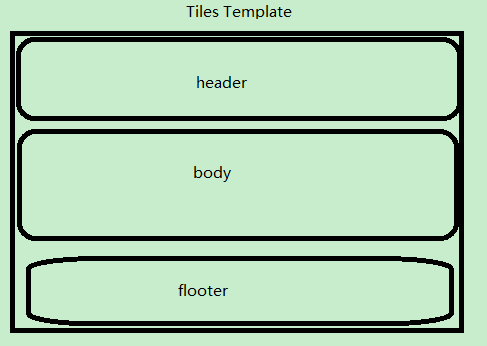Tiles介绍
Tiles 是一种JSP布局框架,主要目的是为了将复杂的jsp页面作为一个的页面的部分机能,然后用来组合成一个最终表示用页面用的,这样的话,便于对页面的各个机能的变更及维护。 Tiles使得struts在页面的处理方面多了一种选择。并且更容易实现代码的重用。有点类是jsp:inlcude。
Tiles模版
在Tiles中,模板(Template)是一个页面的布局部分。你能将一个页面结构看成是由不同的需要填补空白组成,本例中采用的模版结构如下:

Tiles使用步骤
- 新建一个maven web项目,可以参照:【Maven】Eclipse 使用Maven创建Java Web项目
- 引入tiles所需要的jar包。在pom文件中添加依赖
1 <project xmlns="http://maven.apache.org/POM/4.0.0" xmlns:xsi="http://www.w3.org/2001/XMLSchema-instance" 2 xsi:schemaLocation="http://maven.apache.org/POM/4.0.0 http://maven.apache.org/maven-v4_0_0.xsd"> 3 <modelVersion>4.0.0</modelVersion> 4 <groupId>com.hd</groupId> 5 <artifactId>test-tiles</artifactId> 6 <packaging>war</packaging> 7 <version>0.0.1-SNAPSHOT</version> 8 <name>test-tiles Maven Webapp</name> 9 <url>http://maven.apache.org</url> 10 <dependencies> 11 12 <!-- https://mvnrepository.com/artifact/org.apache.tiles/tiles-jsp --> 13 <dependency> 14 <groupId>org.apache.tiles</groupId> 15 <artifactId>tiles-jsp</artifactId> 16 <version>3.0.5</version> 17 </dependency> 18 <!-- https://mvnrepository.com/artifact/org.apache.tiles/tiles-servlet --> 19 <dependency> 20 <groupId>org.apache.tiles</groupId> 21 <artifactId>tiles-servlet</artifactId> 22 <version>3.0.5</version> 23 </dependency> 24 <!-- https://mvnrepository.com/artifact/org.apache.tiles/tiles-extras --> 25 <dependency> 26 <groupId>org.apache.tiles</groupId> 27 <artifactId>tiles-extras</artifactId> 28 <version>3.0.5</version> 29 </dependency> 30 31 <!-- Servlet --> 32 <dependency> 33 <groupId>javax.servlet</groupId> 34 <artifactId>javax.servlet-api</artifactId> 35 <version>3.0.1</version> 36 <scope>provided</scope> 37 </dependency> 38 <dependency> 39 <groupId>javax.servlet.jsp</groupId> 40 <artifactId>jsp-api</artifactId> 41 <version>2.2</version> 42 <scope>provided</scope> 43 </dependency> 44 45 <dependency> 46 <groupId>junit</groupId> 47 <artifactId>junit</artifactId> 48 <version>3.8.1</version> 49 <scope>test</scope> 50 </dependency> 51 </dependencies> 52 <build> 53 <finalName>test-tiles</finalName> 54 </build> 55 </project>
- 创建一个模版,在webapp/view/core中新建一个test-layout.jsp
1 <%@ page language="java" contentType="text/html; charset=UTF-8" 2 pageEncoding="UTF-8"%> 3 <%@ taglib prefix="tiles" uri="http://tiles.apache.org/tags-tiles"%> 4 <!DOCTYPE html> 5 <html lang="en"> 6 <head> 7 <meta charset="utf-8"> 8 <meta name="viewport" 9 content="width=device-width, initial-scale=1.0, maximum-scale=1.0"> 10 11 <title><tiles:insertAttribute name="title" ignore="true" /></title> 12 13 <tiles:insertAttribute name="cssresources" /> 14 </head> 15 <body class="sticky-header"> 16 17 <tiles:insertAttribute name="header" /> 18 <tiles:insertAttribute name="body" /> 19 <tiles:insertAttribute name="footer" /> 20 </body> 21 <tiles:insertAttribute name="jsresources" /> 22 </html>
- 创建组成页面 ,如下图:


1 <%@ page language="java" contentType="text/html; charset=UTF-8" 2 pageEncoding="UTF-8"%> 3 <div> 4 这是头部 5 </div>

1 <%@ page language="java" contentType="text/html; charset=UTF-8" 2 pageEncoding="UTF-8"%> 3 <%@ taglib prefix="tiles" uri="http://tiles.apache.org/tags-tiles"%> 4 5 <tiles:insertDefinition name="index" />

1 <%@ page language="java" contentType="text/html; charset=UTF-8" 2 pageEncoding="UTF-8"%> 3 <button onclick="go(123)">body按钮</button>

1 <%@ page language="java" contentType="text/html; charset=UTF-8" 2 pageEncoding="UTF-8"%> 3 <div> 4 这是尾部 5 </div>

1 <%@ page language="java" contentType="text/html; charset=UTF-8" 2 pageEncoding="UTF-8"%> 3 4 <script src="js/test.js"></script>

1 <%@ page language="java" contentType="text/html; charset=UTF-8" 2 pageEncoding="UTF-8"%> 3 4 <link href="css/test.css" rel="stylesheet"> 5

1 function go(content) 2 { 3 alert(content); 4 }

1 div { 2 border: 1px solid black; 3 }
5. 创建一个定义,在webapp/tiles/test-tiles.xml文件
默认情况,“定义”文件是/WEB-INF/tiles.xml。如果你使用的是CompleteAutoloadTilesListener,tiles将会使用webapp目录下按/WEB-INF/tiles*.xml匹配或classpath下按/META-INF/tiles*.xml匹配的任何文件作为“定义 ”文件;如果发现多个,tiles将会合并这些文件到一起。
1 <?xml version="1.0" encoding="UTF-8" ?> 2 <!DOCTYPE tiles-definitions PUBLIC 3 "-//Apache Software Foundation//DTD Tiles Configuration 3.0//EN" 4 "http://tiles.apache.org/dtds/tiles-config_3_0.dtd"> 5 <!-- http://tiles.apache.org/framework/config-reference.html --> 6 <tiles-definitions> 7 <!-- tiles基础模板 --> 8 <definition name="baseTemplate" template="/view/core/test-layout.jsp"> 9 <put-attribute name="title" value="标题" /> 10 <put-attribute name="cssresources" value="/view/core/test-css.jsp" /> 11 <put-attribute name="jsresources" value="/view/core/test-js.jsp" /> 12 <put-attribute name="header" value="/view/core/test-header.jsp" /> 13 <put-attribute name="body" value="" /> 14 <put-attribute name="footer" value="/view/core/test-footer.jsp" /> 15 </definition> 16 17 <definition name="index" extends="baseTemplate"> 18 <put-attribute name="title" value="首页" /> 19 <put-attribute name="body" value="/view/core/test-body.jsp" /> 20 </definition> 21 22 </tiles-definitions>
6. 在web.xml中添加Tiles监听器
1 <?xml version="1.0" encoding="UTF-8"?> 2 <web-app xmlns:xsi="http://www.w3.org/2001/XMLSchema-instance" 3 xmlns="http://java.sun.com/xml/ns/javaee" 4 xsi:schemaLocation="http://java.sun.com/xml/ns/javaee http://java.sun.com/xml/ns/javaee/web-app_3_0.xsd" 5 id="WebApp_ID" version="3.0"> 6 <display-name>test-tiles</display-name> 7 8 <!-- 自定义tiles监听器 --> 9 <listener> 10 <listener-class>com.test.listener.TestListener</listener-class> 11 </listener> 12 13 <!-- tiles监听器,默认配置文件在/WEB-INF/tiles*.xml 14 <listener> 15 <listener-class>org.apache.tiles.extras.complete.CompleteAutoloadTilesListener</listener-class> 16 </listener> 17 --> 18 <welcome-file-list> 19 <welcome-file>index.jsp</welcome-file> 20 </welcome-file-list> 21 </web-app>
自定义tiles监听器,TestListener

1 package com.test.listener; 2 3 import java.util.ArrayList; 4 import java.util.List; 5 6 import org.apache.tiles.factory.AbstractTilesContainerFactory; 7 import org.apache.tiles.factory.BasicTilesContainerFactory; 8 import org.apache.tiles.request.ApplicationContext; 9 import org.apache.tiles.request.ApplicationResource; 10 import org.apache.tiles.startup.AbstractTilesInitializer; 11 import org.apache.tiles.startup.TilesInitializer; 12 import org.apache.tiles.web.startup.simple.SimpleTilesListener; 13 14 public class TestListener extends SimpleTilesListener { 15 16 @Override 17 protected TilesInitializer createTilesInitializer() { 18 19 return new AbstractTilesInitializer(){ 20 @Override 21 protected AbstractTilesContainerFactory createContainerFactory(ApplicationContext context) { 22 23 BasicTilesContainerFactory basicTilesContainerFactory = new BasicTilesContainerFactory(){ 24 @Override 25 protected List<ApplicationResource> getSources(ApplicationContext applicationContext) { 26 //applicationContext.getResources(“/ WEB-INF / my-tiles-definitions-file.xml”); 27 28 List<ApplicationResource> retValue = new ArrayList<ApplicationResource>(1); 29 retValue.add(applicationContext.getResource("/tiles/test-tiles.xml"));//修改tiles文件位置 30 return retValue; 31 //return super.getSources(applicationContext); 32 } 33 }; 34 return basicTilesContainerFactory; 35 } 36 }; 37 } 38 39 }
7. 发布到tomcat中,并启动tomcat

8. 在浏览器中访问 http://localhost:8080/test-tiles

Tiles在SpringMVC中应用
- 新建一个maven springmvc web项目,参照:【Maven】Eclipse 使用Maven创建SpringMVC Web项目
- 配置tiles,如上面的步骤(除去添加tiles监听器的步骤,只要在springmvc配置tiles即可)
- 在springmvc的配置文件中加入一下内容:
1 <!-- tiles视图解释类 --> 2 <bean id="tilesViewResolver" class="org.springframework.web.servlet.view.UrlBasedViewResolver"> 3 <property name="viewClass" value="org.springframework.web.servlet.view.tiles3.TilesView" /> 4 </bean> 5 6 <!-- tiles配置路径 --> 7 <bean id="tilesConfigurer" class="org.springframework.web.servlet.view.tiles3.TilesConfigurer"> 8 <property name="definitions"> 9 <list> 10 <value>/tiles/*.xml</value> 11 </list> 12 </property> 13 </bean>
- 写一个测试的controller,TestController.java
1 package com.test.controller; 2 3 import javax.servlet.http.HttpServletRequest; 4 5 import org.springframework.stereotype.Controller; 6 import org.springframework.web.bind.annotation.RequestMapping; 7 8 @Controller 9 @RequestMapping("/testController") 10 public class TestController { 11 12 @RequestMapping(value="/getView") 13 public String getTest(HttpServletRequest request){ 14 15 return "index";//返回tiles定义中的name 16 17 } 18 }
- 发布到tomcat,在浏览器中访问TestController中的getTest方法,即可返回界面





 浙公网安备 33010602011771号
浙公网安备 33010602011771号